Modern Lace Making

The Delineator magazine provides an illustrated overview of lace-making through a variety of short projects including a lady’s scarf, ribbon tie, rosette, and a Sorrento wheel.
Ladies’ Scarf in Modern Lace
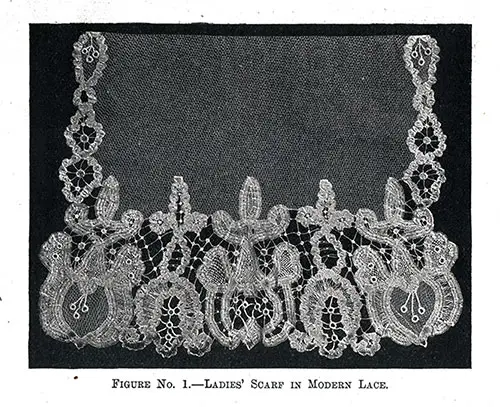
Figure No. 1. — Of the many scarfs and ties illustrated, few can compare with the beauty of that shown in figure No. 1. It is planned on such broad and liberal lines, that at first glance one is almost forced to utter extravagance.
The richness and beauty of the scarf justify one in this thought, for unless the wearer is the maker a tie of this description is very costly as well as rare, for they are usually made only to order.
Both point and ' Bruges braid are used for this lace, and many of the connecting and filling in stitches are spiders which are illustrated and explained later in this article.
The lower part of the center medallion is composed of rings, joined together by corded button-hole bars, above which is a spider on either side. This is framed on both sides by an insertion of Bruges stitches placed rather far apart.
The next form is oval in shape, the center of which is composed of a perpendicular bar of rings connected with the braid by button-hole bars in the manner just described. Complete this form by an outer braid to which the Russian stitch joins it.
A border of this stitch forms the outside of the large medallion on the end, and although the space appears rather broad for this stitch, the working of a number very, very close together forms an exceedingly handsome and lacy border.
The upper portion is filled in with point de Bruxelles stitch inlaid with rings.
The center of the net employed for the scarf proper, and on this are placed bars worked with over-and-over stitch and finished on the ends with rings to represent the stamens of a flower. Also, here let it be emphasized.
In all net ties and scarfs use only the best quality Brussels net, as an inferior quality wears so poorly that it is not worth putting any handmade lace upon it.
The difference in the cost is very slight, and the superior quality permits frequent renovations. Finish the sides with an outline following the general lines of the design on the ends.
Lace End for Ribbon Tie
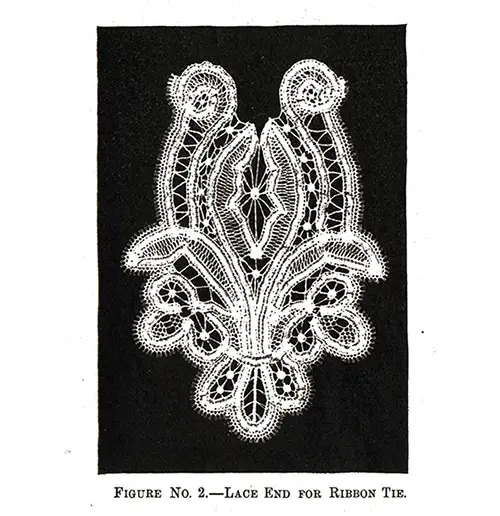
Figure No. 2. — In this illustration is shown a tie-end of the narrow order. The narrow Battenberg braid is employed for this, and the stitches are mainly the Sorrento bars and Russian stitch, together with the spider or wheel illustrated at figures Nos. 4 and 5.
The whole is outlined with a picot edging; make the tie itself out of ribbon, the ends of which are finished with the lace neatly applied. For the designs shown at figures Nos. 1 and 2, thanks are due Sara Hadley, professional lace-maker, 923 Broadway, New York.
Rosette in Raised Point d’Angleterre
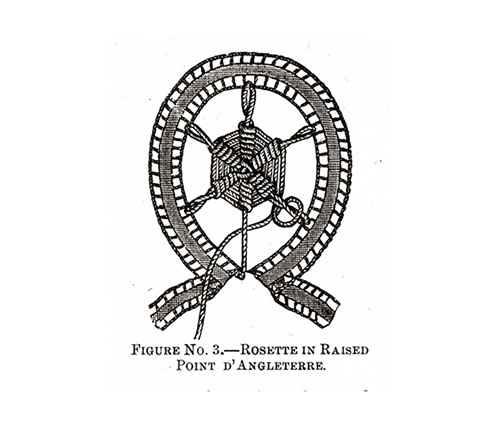
Figure No. 3.—This illustration shows the Point d’Angleterre rosette, which although more elaborate than those illustrated at figures Nos. 4 and 5 is in reality of the spider class.
It is worked according to the directions given for the plain spider or wheel at illustration No. 4, but instead of having any desired number of bars for the foundation, the wheels are made preferably, with six rays divergent from the center.
After the twisted bars are worked, instead of winding the thread under and over the radii the needle is inserted under each radius with the point toward you and brought out again between the thread and the last stitch on this radius.
The next stitch is worked over the next ray from you, bringing the needle out between the thread and the finished stitch as directed. This produces a kind of button-hole stitch; the result of which is a coil over each radius, thus giving the firm appearance possessed by this wheel.
Continue till the center is the desired size, fasten with a button-hole stitch, and twist the thread over the remaining radius to the place of beginning.
Detail of Flat Spider or Sorrento Wheel
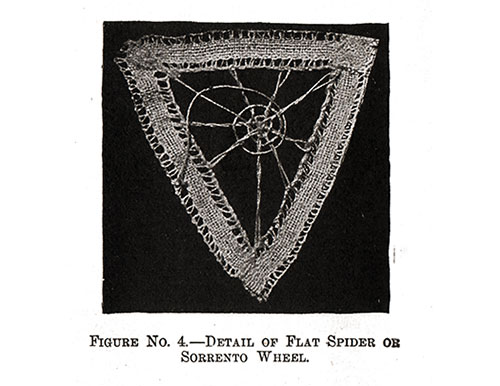
Figure No. 4. — In this illustration is shown the detail for working a fiat wheel or spider. This is the simplest of all the spiders made and may be used in places where the shaping is round or square, regular, or irregular; and as it is easily accomplished and very effective it may be largely employed in working all laces.
An exceptionally light and dainty appearance may be given by using a fine thread and working only small spiders (see figure No. 1), while a heavy effect may be produced by the use of heavy thread and large centers, as illustrated at figure No. G, or heavier still by working the Point d’Angleterre rosettes.
In working the spider, as shown in the Detail, the foundation is composed of plain twisted bars cast from one side of the space to be filled in, to the other, in such a manner that they cross in the center.
These distances may be even or uneven according to the choice of the worker, but for this style of spider, an uneven number of spokes or radii should be provided, so that the over and under weaving will be brought out evenly.
When the bars are uneven in number the work will not finish correctly or after the manner intended, although, for various styles of wheels, prominent among which is the d’Angleterre rosette, an even number of rays is allowable.
The thread is fastened in the upper left-hand corner, carried a little to one side of the center on the opposite braid and attached; it is then twisted like the Sorrento bar back to the center.
Carry the thread to the right-hand corner and twist back to the center, work to the braid opposite a little below the center and twist back again.
Work to the right-hand side of the top braid, twist back to center and work to point at the bottom then twist back again.
Work spoke at the right of point, twist back, and work at left below first spoke, twist back; carry the thread to the remaining space in the top braid, and twist back to center and with one plain or buttonhole stitch fasten all stitches together.
Work the spider by passing the needle over one radius and under the next, as for ordinary darning, drawing the thread toward the center; after this the thread is twisted around the remaining radius.
This will form a center where every alternate radius is uppermost of the spider, and if the needle is thrust through the twisted bar occasionally, the spider will be the better held in position.
Flat Spider or Sorrento Wheel
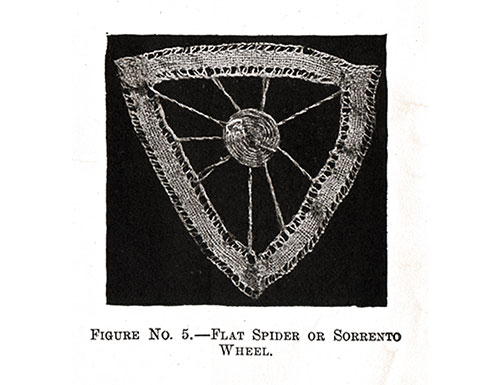
Figure No. 5. — In this illustration is shown the effect of the finished spider. Another method is as follows:
Fasten the thread in the corner as directed, carry it across to the opposite braid and twist back to the starting point instead of only to the center.
Overcast the braid to a point where the next spoke is to begin and carry this across to the proper place on the opposite braid, twisting back to the beginning.
Each Sorrento bar is made separate and complete, excepting the last, which is twisted only to the center where all the bars are brought together, and the spider has woven.
“Modern Lace-Making,” in The Delineator: An Illustrated Magazine of Literature and Fashion, Paris-London-New York: The Butterick Publishing Co. Ltd., Vol. LVI, No. 4, October 1900, p. 525-526.
Note: We have edited this text to correct grammatical errors and improve word choice to clarify the article for today’s readers. Changes made are typically minor, and we often left passive text “as is.” Those who need to quote the article directly should verify any changes by reviewing the original material.
